法语小学基础训练第270期
- 格式:docx
- 大小:12.14 KB
- 文档页数:3
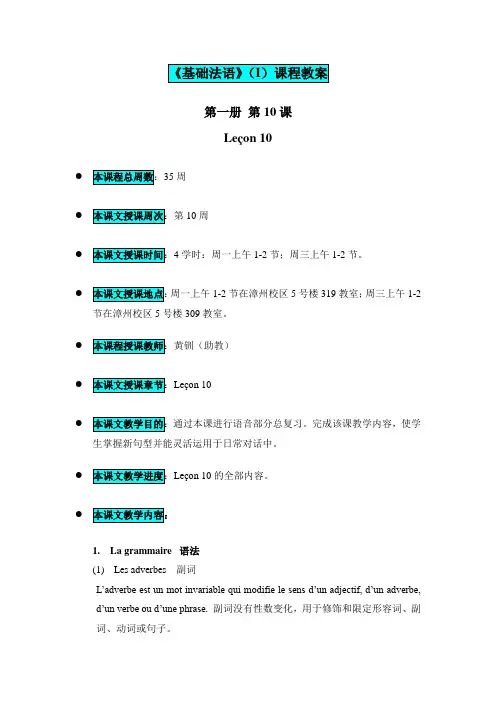
第一册第10课Leçon 10●35周●10周●4学时:周一上午1-2节;周三上午1-2节。
●周一上午1-2节在漳州校区5号楼319教室;周三上午1-2节在漳州校区5号楼309教室。
●●Leçon 10●生掌握新句型并能灵活运用于日常对话中。
●Leçon 10的全部内容。
● grammaire 语法(1)Les adverbes 副词L’adverbe est un mot invariable qui modifie le sens d’un adjectif, d’un adverbe, d’un verbe ou d’une phrase.副词没有性数变化,用于修饰和限定形容词、副词、动词或句子。
●L’emploi et place des adverbes副词的用法和位置:-- devant l’adjectif ou l’adve rbe dont il précise le sens.位于限定的形容词或副词前Ex. Il est très gentil.Il parle très bien le français.C’est un institut bien connu.-- après le verbe 位于动词后Ex. Il parle bien le français.Elle mange beaucoup.-- dans une phras e, la place de l’adverbe est variable.在句子中位置灵活多变Ex. Aujourd’hui, je vais au café avec mes amis.Il arrive aujourd’hui.●Adverbe interrogatif 疑问副词-- commentEx. -- Comment allez-vous ? -- Je vais très bien.-- Il travaille comment ? -- Il travaille mal.-- combienEx. – Combien êtes-vous dans votre classe ?-- Nous sommes quinze dans notre classe.combien de + nom-- Combien de personnes y a-t-il dans votre classe ?-- Il y a seize personnes dans notre classe.-- Combien de chemises y a-t-il dans ta valise ?-- Il y a deux chemises dans ma valise.(2)Les pronoms personnels toniques 重读人称代词Singulier 单数: moi toi lui ellePluriel 复数: nous vous eux ellesL’emploi 用法 :-- Quand on ne répéte pas le verbe : 用于无动词的省略句Ex. Comment allez-vous ?Très bien, merci. Et vous ?Moi aussi, merci.-- Attribut 做表语Ex. Qui est là ?C’est moi.-- Après une proposition (à, chez, de, à côté de...) et après «et ».位于介词或连词后Ex. Il habite à Paris avec elle.A côté de lui, c’est sa mère.Ils sont chez eux.Toi et moi, nous allons à la gare.-- Remarquer le pronom sujet. 做主语同位语强调主语Ex. Toi, que fais-tu là ?Moi, je travaille.2.Textes. 课文(1)structures 句型:日常问候语:-- ça va ? ( Comment ça va ? )-- Oui, ça va (bien). / Non, ça ne va pas bien. / ça va mal.问人数或数量:-- Combien êtes-vous dans votre classe / famille / institut / université... ?-- Nous sommes... dans notre...-- Combien de personnes / d’étudiants... y a-t-il dans votre classe / institut... ?-- Il y a... dans...-- Combien sont-ils dans leur famille / classe... ?-- Ils sont...avoir + 数字+ an(s) 表示年龄Ex. J’ai vingt-cinq ans.Il a un an.Elle a seize ans.Remarques 课文难点注释-Il y a sept filles et huit garçons.On ne prononce pas la consonne finale de «cinq, six, huit et dix » lorsque le mot suivant commence par une consonne.法语中5、6、8、10这四个数字词尾字母正常情况下要发音,但是当它们后面紧接着辅音开头的单词时,词尾字母不发音。
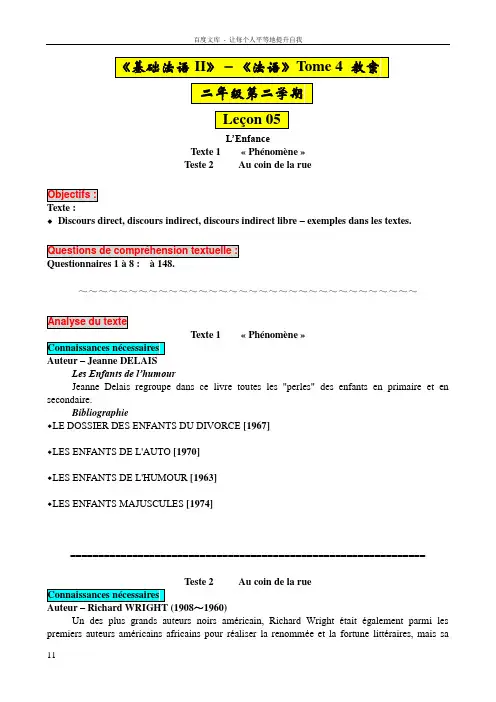
《基础法语II》-《法语》Tome 4 教案二年级第二学期Leçon 05L’EnfanceTexte 1 « Phénomène »Teste 2 Au coin de la rueObjectifs :Discours direct, discours indirect, discours indirect libre – exemples dans les textes. Questions de compréhension textuelle :~~~~~~~~~~~~~~~~~~~~~~~~~~~~~~~~~~Analyse du texteTexte 1 « Phénomène »Connaissances nécessairesLes Enfants de l’humourJeanne Delais regroupe dans ce livre toutes les "perles" des enfants en primaire et en secondaire.Bibliographie✹LE DOSSIER DES ENFANTS DU DIVORCE [1967]✹LES ENFANTS DE L'AUTO [1970]✹LES ENFANTS DE L'HUMOUR [1963]✹LES ENFANTS MAJUSCULES [1974]===============================================================Teste 2 Au coin de la rueConnaissances nécessaires~1960)Un des plus grands auteurs noirs américain, Richard Wright était également parmi les premiers auteurs américains africains pour réaliser la renommée et la fortune littéraires, mais saréputation a moins affaire avec la couleur de sa peau qu‘avec la qualité superbe de son travail.Il connut, dès son enfance, la pauvreté et la violence de la ségrégation raciale aux États-Unis. Il ne cessera de dénoncer - dans des romans sublimes comme Native Son (1940) ou dans des essais comme Puissance noire (1954)- les humiliations imposées à des millions de personnes en raison de la couleur de leur peau. Une nouvelle biographie, fondée en partie sur des rapports du FBI récemment rendus publics, rappelle l'itinéraire de cet écrivain qui fut aussi l'un des premiers militants antiracistes.Malgré les obstacles incroyables que cette société a dressés sur son chemin, ce « petit garçon noir » est devenu un romancier célèbre, auteur de livres comme Uncle Tom’s Children(1938), Native Son (1940), Black Boy (1945) et beaucoup d'autres...=========================================================== Analyses textuels et syntaxiquesance◆voir les textes dans la méthode.Questions de compréhension textuelle :Exercices dans la méthode~~~~~~~~~~~~~~~~~~~~~~~~~~~~~~~~~~Vocabulaire( même forme au mas. et au fém., pluriel braves )✹1). gentil et honnête, mais d'une simplicité un peu naïve✹[Remarque d'usage: toujours avant le nom et souvent un peu péjoratif]un brave homme très serviable✹2). qui est courageux et n'a pas peur d'affronter le combat (vieilli)✹[Remarque d'usage: après le nom]✹Syn. : vaillantun soldat très brave❖S’en donner locution verbale✹s'accorder du plaisir (familier; vieilli)Les jeunes s’en sont donné toute la nuit.Ce brave homme s’en donne follement avec mon petit frère.✹Pour renforcer l’expressivité, on utiliserait «s’en donner à coeur joie », expression signifiant que l’on accomplit une tâche ( ou qch. d’une certaine importance) avec la joie du coeur.❖Tour .✹1). action rusée (vieilli)Syn. : ruseon connaît ses tours, il ne nous aura pas.✹2). action malhonnête ou malveillanteSyn. : méchancetéjouer un vilain tour à qn.Faire des mauvais tours à qn.❖Bombarder vt.✹1). 炮轰✹2). harceler ou accabler (quelqu‘un) (familier) 纠缠;烦扰✹[Remarque d'usage: suivi d'un complément d'objet second introduit par la préposition: "de"]Il la bombarde de lettres.✹3). prendre pour cible (quelque chose ou quelqu‘un en lançant des projectiles) (familier) 用大量的……向……投掷[Remarque d'usage: suivi d'un complément d'objet second introduit par la préposition: "de"] Synonyme: mitraillerOn les a bombardés de tomates.❖Édulorer vt.✹1). donner une saveur douce et sucrée (à un aliment ou à une boisson) 使带甜味儿;冲淡édulcorer un entremets✹2. modifier l‘expression (d’un texte) pour supprimer les éléments susceptibles de choquer ou de déplaire 〔转〕冲淡、缓和(原本有可能会令人不满或不安的言语或篇章)édulcorer les paroles d'une chansonJ’édulcore les pensées de ce brave homme, juste pour lui rendre un peu plus d’intelligence.❖Fuir vi. 逃走;vt.躲避✹1). se dérober pour ne pas être confronté à la réalité de (quelque chose) 逃避(责任、真相等) fuir ses responsabilités✹2). partir rapidement pour se soustraire à (un danger ou une épreuve pénible) 躲避(危险等) fuir le combatS’enfuir . absolu 飞快地逃走;逃跑✹1). partir très vite (d‘un lieu) 逃跑s'enfuir à toutes jambes✹2). s‘échapper (d’un lieu clos) 溜走,潜逃✹Syn. : s'évaderil s'était enfui de prison✹3). disparaître progressivement 渐渐流逝la jeunesse qui s'enfuit❖S’emparer de . absolu 攻占;夺取Désemparer .✹jeter (quelqu‘un) dans le trouble 使…有麻烦✹Syn. : déconcerter / décontenancerLes questions de l'examinateur ont désemparé le candidat.✹MARINE mettre (un navire) hors d‘usage 使…损坏到无法再使用La tempête a désemparé le bâtiment.Sans désemparer locution adverbiale✹sans s‘arrêter (soutenu) 一刻不停J'ai travaillé toute la nuit sans désemparer❖Se battre✹1). 对打,打架,对阵Les deux frères commencent à se battre.Les troupes se sont battus pendant 3 jours.✹2). Se battre contre (avec) ... 与…作斗争Les villageois se battaient péniblement contre la grande sécheresse.❖Se débattre✹1). faire de violents efforts pour s‘échapper✹力图脱身;竭力挣扎Syn. : se démenerQuand on l’a saisi, l’oiseau se débattait, désespérément.✹2). lutter énergiquement (pour surmonter une difficulté) 奋争✹Syn. : se battreSon entreprise récemment fermée, il se débat avec des problèmes financiers.❖S’abattre (sur qch. / qn.)✹1). être jeté ou déversé d‘une manière brusque et violente 倾泻;猛袭Des pluies diluviennes se sont abattues sur le pays.✹2). tomber brutalement 猛地倒下La cheminée s'est abattue, touchée par la foudre.✹3). se précipiter en arrivant vivement奇袭;猛扑Syn. : fondre surL'armée s'est abattue sur l'ennemi.✹4). se laisser tomber brusquement (soutenu) 躺倒La jeune fille s'abattit sur un fauteuil.❖Aviser vt. / vi.✹1). informer (quelqu‘un) de (quelque chose) 告知Le directeur ne nous a pas avisés des absences répétées de notre fils.✹2). apercevoir (quelque chose ou quelqu‘un) (soutenu) 觉察Il avisa un banc et décida d'aller s'y reposer.✹3). réfléchir avant de prendre une décision ou de faire qch. 思考Merci de m'avoir prévenu, j'aviserai et je vous rappellerai.S’aviser de + qch. / + inf.✹1). prendre la liberté de (faire quelque chose d‘interdit ou de blâmable) 竟敢;胆敢 Si tu t'avises de sortir tu auras affaire à lui.✹2). prendre conscience de (quelque chose qu‘on n’avait pas remarqué auparavant) 突然察觉到 Je me suis avisée brusquement que la rue était déserte.Il s’avisa enfin de ce qu’il fallait faire dans ce cas-là.❖Pleurer à chaudes larmes✹Pleurer en répandant quantité de larmesSyn. : fondre en larmes; pleurer toutes les larmes de son corpsPleine de remords, elle pleurait à chaudes larmes.La nouvelle l’a fait fondre en larm es.❖Prendre son parti de qch. locution verbale✹(faute de pouvoir faire autrement), s‘accommoder d’une situation fâcheuse ou malheureuse 因无力改变而容忍某事Il a pris son parti de l'évolution des mœurs.L’opium console tout, fait prendre son parti de t out... (Maupassant)Excusez-moi mais je ne suis pas celui qui prend son parti de toute injustice.❖De nouveau✹une fois de plus et comme déjàêtre de nouveau ouvert au publicExaminer de nouveau le problème❖À nouveau✹1). une fois de plus et d’une manière différente/nouvelle (vieilli)examiner à nouveau le problème✹2). une fois de plus et comme déjà✹Syn: de nouveautravailler à nouveau❖À bout de locution prépositionnelle✹arrivé à l'extrême maximum de ses capacités en matière de (quelque chose)L'avocat est à bout d'arguments.À bout de souffle / À bout de forces, je ne puis plus jamais faire un seul pas d’avance.❖Au bout de locution prépositionnelle✹1). à la limite extrême deTu pourras trouver un magasin mignon et chic au bout de la rue.✹2). après une période ou une durée deL'accusé a avoué au bout de quelques minutes.~~~~~~~~~~~~~~~~~~~~~~~~~~~~~~~~~~。
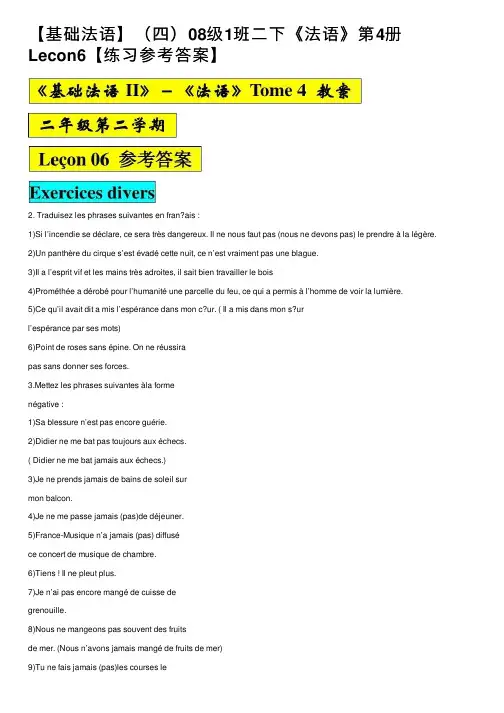
【基础法语】(四)08级1班⼆下《法语》第4册Lecon6【练习参考答案】2. Traduisez les phrases suivantes en fran?ais :1)Si l’incendie se déclare, ce sera très dangereux. Il ne nous faut pas (nous ne devons pas) le prendre à la légère.2)Un panthère du cirque s’est évadé cette nuit, ce n’est vraiment pas une blague.3)Il a l’esprit vif et les mains très adroites, il sait bien travailler le bois4)Prométhée a dérobé pour l’humanité une parcelle du feu, ce qui a permis à l’homme de voir la lumière.5)Ce qu’il avait dit a mis l’espérance dans mon c?ur. ( Il a mis dans mon s?url’espérance par ses mots)6)Point de roses sans épine. On ne réussirapas sans donner ses forces.3.Mettez les phrases suivantes àla formenégative :1)Sa blessure n’est pas encore guérie.2)Didier ne me bat pas toujours aux échecs.( Didier ne me bat jamais aux échecs.)3)Je ne prends jamais de bains de soleil surmon balcon.4)Je ne me passe jamais (pas)de déjeuner.5)France-Musique n’a jamais (pas) diffuséce concert de musique de chambre.6)Tiens ! Il ne pleut plus.7)Je n’ai pas encore mangé de cuisse degrenouille.8)Nous ne mangeons pas souvent des fruitsde mer. (Nous n’avons jamais mangé de fruits de mer)9)Tu ne fais jamais (pas)les courses lesamedi.10)Jean- Baptiste ne veut plus de purée.11)Nous ne sommes pas allés en Norvège12)Il n’a pas encore donné sa réponse.13)Je ne d?ne jamais (pas) dans cerestaurant.14)On n’a jamais vu de neige à Paris enjuin.15)Les cours de droit de première annéen’ont plus lieu dans l’amphithéatre Sully. 16)Dans notre enfance, nous n’allons ja mais (pas) au bord de la mer.17)Mon mari ne rentre jamais (pas) avant17 heures.18)Nous ne passons jamais (pas) nosvacances au même endroit.4.Donnez la forme négative des mots soulignés en utilisant l’un des préfixes donnés : 1)im / in / ir(1)C’est une phrase correcte.(incorrecte)(2)C’est une histoire vraisemblable.( invraisemblable)(3)Il est conscient du danger.( inconscient)(4)Il a eu une réaction tout àfaitcompréhensible.( incompréhensible)(5)Je suis capable de changer une rouede voiture en cinq minutes.(incapable)(6)C’est un nombre pair. ( impair)(7)C’était un accident prévisible.(imprévisible)(8)Il est patient. (impatient)(9)Ce terrain est perméable.(imperméable)(10)Votre écriture est lisible. (illisible)(11)Ce que vous avez fait est légal.(illégal)(12)Ce verbe est régulier. ( irrégulier)(13)Votre projet semble réalisable.(irréalisable)2)mé / mal(1)Il a toujours l’air content.( mécontent)(2)Ce climat est très sain. (malsain)(3)Il a des gestes très adroits.(maladroits)(4)C’est un commer?ant honnête.( malhonnête)(5)Cet enfant semble heureux.(malheureux)5.Remplacez le verbe passe-partout se trouver par un verbe plus précis : 1)E n face de la fenêtre s’élève / se dresse unarbre centenaire.2)D e nombreux voyageurs se pressent dansla petite salle s’attente.3)A u milieu de la place s’élève / se dresse unobélisque.4)C’est dans l’action que se manifeste toutl’intérêt du roman.5)L es fautes les plus amusantes serencontrent dans les textes d’enfants.6.Donnez le nom des adjectifs suivants :adjectifsnoms fémininsinnocentinnocenceviolentviolenceconscientconsciencecohérentcohérence7.C omplétez en utilisant à ou chezIl faudra d’abord passer à la teinturerie et àla boulangerie, puis porter les draps àla laverie, penser à aller chez l’épicier et àla boulangerie avant d’aller chez le docteur. En revenant, il faudra encore s’arrêter chez le charcutier et porter la feuille de sécurit sociale au pharmacien. De retour à la maison, téléphoner au plombier et prendre rendez-vous chez le coiffeur.13. Compréhension rapide : oui ou non ?1)oui2)non3)oui4)oui5)non6)non1.Répondez négativement aux questionssuivantes :1)Il n’y a rien d’intéressant.2)Je n’ai rien d’autre à faire.3)Je ne connais personne de compétent.4)Personne d’autre ne veut parler./doc/d48196daa58da0116c1749ab.html plétez les phrases suivantes par ?n’importe qui, n’importe quoi, n’importe où, n’importe quand, n’importe comment, n’importe lequel, n’importe quel(le) ? :1)Il ne réfléchit pas assez. Il dit souventn’importe quoi.2)Elle ne s’intéresse pas à la mode. Elles’habille v raiment n’importe comment.3)J’irai n’importe où pour trouver du soleil.4)On peut se faire servir dans ce restaurantà n’importe quelle heure.5)On ne cultive pas le riz sous n’importequel climat.6)Cet enfant est trop confiant. Il suivraitn’importe qui dans la rue.7)Les chats sont souvent difficiles à nourrir.Ils ne mangent pas n’importe quoi.8)Ces deux autobus vont àla Bastille. Vouspouvez prendre n’importe lequel.9)Vous pouvez passer n’importe quand, il ya toujours quelqu’un à la maison.10)N e laisse pas tra?ner tes affaires n’importeoù !3.Remplacez , si c’est possible, la négationconjointe par la négation disjointe etvice versa :1)Il travaille, mais pas à cette usine.2)Il viendra, mais elle ne viendra pas.3)Je veux travailler, mais non comme unesclave. ( Je ne veux pas travailler comme un esclave.)4)Il n’a pas parlé sans raison. (Il a parlénon sans raison.)5)Je ne veux pas partir sans leur dire adieu.( Je veux partir, mais non sans leur dire adieu.)6)Il n’est pas venu à huit heures. ( Il est venu,mais pas à huit heures.)7)Il n’est pas venu à huit heures, mais à neufheures. (il est venu à neuf heures, non à huit heures.)8)Ce sont des travailleurs non professionnels.( Ce ne sont pas des travailleurs professionnel.)9)C’était croire au gain d’une partie parmême engagée. ( Ce n’était pas croire au gain d’une partie engagée.)10)Il était orgueilleux ; non vaniteux. ( Ilétait pas vaniteux, mais orgueilleux.)4.Remplacez seul et seulement par ne … que : 1)Il n’aime la mer qu’à cause de sestempêtes.2)Il n’y a que le professeur dans le bureau.3)Il ne parle pas qu’à ses compatriotes.4)Il n’apprend pas sa le?on, il ne fait quebavarder.5.Faites entre les mots suivants là ou il le faut :non, ne, pas plus, jamais, rien, rien que, jamais de la vie :Un témoin insupportableLe juge :Le tém oin : Le juge :Le tém oin Le juge :Le tém oin : Le juge : Nous ouvrons l’interrogatoire du premier témoin. Avancez.J’avance ?Avancez, je vous dis. Quels sont vos nom et prénom ?Pardon, Monsieur le Juge. Je ne crois pas comprendre la question. Votre nom ! Comment vous appelez-vous ?Je m’appelle Jean-Pierre. Enfin. Votre nom de famille, c’est quoi ?Mon grand, Monsieur le Juge. Hein ? C’est votre nom.C’est le nom qu’on me donne dans ma famille. Depuis toujours. Vous riez de moi ?Ah non, Monsieur le Juge, jamais de la vie! Je respecte trop la justice, Monsieur le Juge. Mais vous me demandez mon nom deLe tém oin : Le juge :Le tém oin : Le juge :Le tém oin :Le juge :Le tém oin : Le famille et on m’appelle toujours Mon grand dans ma famille, Monsieur le Juge, surtout Maman…Silence ! Il exagère ! Mais qui m’envoie un témoin pareil? … Bon, ne craignez rien, mon ami. Vous devez essayer derépondre àmes questions. Vous voulez bien ? Quelle est votre profession ? Qu’est-ce que c’est ?Qu’est-ce que vous faites ? Euh, voyons. Je vous regarde et je vous réponds ?Non, non…Je vous tiens un brin de conversation ?Grands dieux ! Ce qu’on doit supporter parfois quand on s’assoit sur un siège de juge !Je vous comprends, Monsieur le Juge. Et je vous plains.Hmm. Revenons àma question. Qu’est-ce que vous faites d’habitude ? Quel est votre métier ?juge :Le tém oin : Le juge :Le tém oin : Le juge :Le tém oin : Le juge :Le tém oin : Le Monsieur le Juge, les temps sont difficiles. Alors je fais ceci, je fais cela…Disons que vous être homme àtout faire.Oui, Monsieur le Juge. Mais mon père dit que je fais tout mal, que je ne vaux rien, que…Mais si, vous valez certainement quelque chose, bi en que … Enfin, passons. Jurez de dire la vérité, toute la véritéet rien que la vérité…Moi, jurer ? Oh, sinon, Monsieur le juge. Là, je fais très attention. Je ne dis jamais de gros mots, je peux vous l’affirmer. Vous avez vu le vol du sac à main de la dame ?Euh…Vous l’avez vu ? Est-ce que vous vous être aper?u de quelque chose d’anormal dans le comportement de la victime ?Ah ! Non, Monsieur le Juge. Je ne me suis aper?u de rien. Maisjuge :Le tém oin : Le juge :Le tém oin : Le juge :Le tém oin : Le juge :Le tém oin j’ai entendu quelque chose et j’ai vu quelque chose.Donc, vous vous être aper?u de quelque chose. C’est bien ce que vous voulez dire. Alors ?Une dame a crié quelque chose et puis j’ai vu un homme courir. Il est passé à c?té de moi.Et vous ne l’avez pas arrêté ? Pourquoi ?J’y ai pensé pendant un moment. Puis, je me suis souvenu des le?ons de maman : réfléchir avant d’agir. J’ai vu la dame poursuivre le monsieur. Elle l’a attrapé. Elle l’a menacé d’un parapluie. Alors, j’ai saisi la dame et j’ai essayé de la calmer. Pendant ce temps le voleur s’est enfui.Oui, heureuse ment que j’ai pu le protéger. Il a manquéde se faire très mal avec le parapluie de la dame.Cet interrogatoire est devenu complètement impossible, et jeLe juge :Le tém oin : Le juge :Le tém oin : Le juge :Le tém oin : Le juge refuse de le poursuivre. Je déclare qu’il n’y a pas eu de crime, ni de voleur, ni de dame, ni de para pluie… Mais surtout, il n’y a pas eu de témoin ! Maintenant, sortez cet homme d’ici. Je ne peux plus le voir. Ouf ! Tout cela m’a donné un horrible mal de tête.( Le juge se retire péniblement):6.Traduisez en fran?ais :训练中⼼le centre d’instruction / le centre d’entra?nement体能训练un entra?nement physique令⼈费解地curieusement鞠躬致意s’incliner急风暴⾬la tempête昙花⼀现的éphémère粗暴地brutalement ⼭穷⽔尽épuiséde ressources (en détresse)惊慌失措s’affoler听命于obéir à与…相对抗s’opposer à通情达理的raisonnable爬⾏marcher àquatre pattes作出牺牲se dévouer捐献faire don de 违⼼的à contre c?ur 发出劈劈啪啪声crépiter驯养apprivoiser les bêtes降温la baisse de température头晕眼花le vertige最近dernièrement 惨绝⼈寰的atroce7. version :1)Que n’a-t-il mangé ? (que ne + ind 表⽰责难,遗憾,意思是:为什么不)他为什么没吃?2)Que n’a-t-il pas mangé ?他没吃什么?3)Je n’y vais pas parce que vous m’y forcez.并不因为你强迫我去我才去。
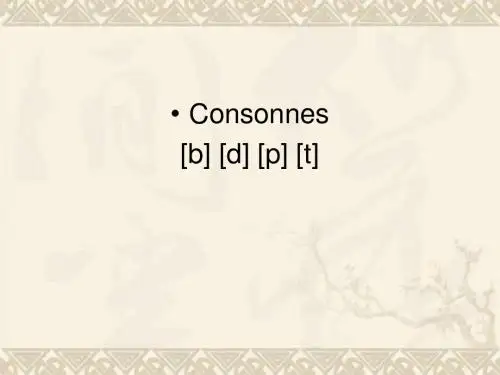
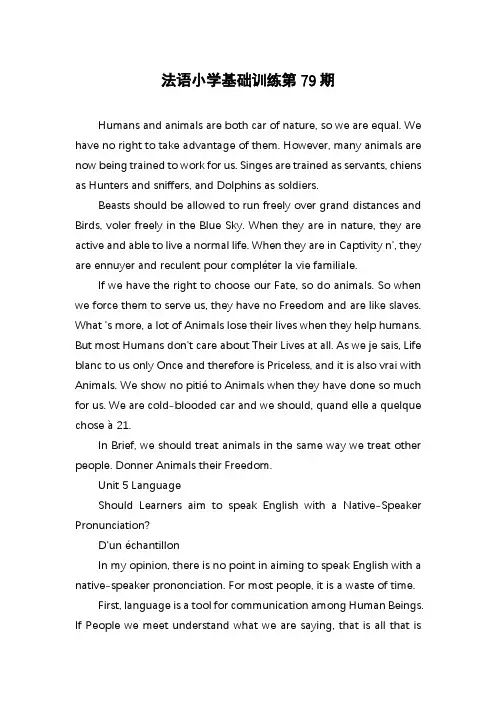
法语小学基础训练第79期Humans and animals are both car of nature, so we are equal. We have no right to take advantage of them. However, many animals are now being trained to work for us. Singes are trained as servants, chiens as Hunters and sniffers, and Dolphins as soldiers.Beasts should be allowed to run freely over grand distances and Birds, voler freely in the Blue Sky. When they are in nature, they are active and able to live a normal life. When they are in Captivity n', they are ennuyer and reculent pour compléter la vie familiale.If we have the right to choose our Fate, so do animals. So when we force them to serve us, they have no Freedom and are like slaves. What 's more, a lot of Animals lose their lives when they help humans. But most Humans don't care about Their Lives at all. As we je sais, Life blanc to us only Once and therefore is Priceless, and it is also vrai with Animals. We show no pitié to Animals when they have done so much for us. We are cold-blooded car and we should, quand elle a quelque chose à 21.In Brief, we should treat animals in the same way we treat other people. Donner Animals their Freedom.Unit 5 LanguageShould Learners aim to speak English with a Native-Speaker Pronunciation?D'un échantillonIn my opinion, there is no point in aiming to speak English with a native-speaker prononciation. For most people, it is a waste of time.First, language is a tool for communication among Human Beings. If People we meet understand what we are saying, that is all that isnecessary. We do not need to imitate un Haut - parleur 's de prononciation. In any case, there are many types of accents, so which one should we choose to imitate?Second, the most important thing is how well on va what we veux to express our Ideas should be clear and facile to understand. To do so, we should be able to Use Right Words and correct grammaire.Third, given the fact that we live in China, it seems a peu Dan for us to try desperately hard to get rid of our national et in order to speak BBC English.Enfin, each of us has our own style when we speak. If we can give Free rein to Personal style, the English-speaking World will become more and more interesting coloré.In a word to speak with my, I par ce and recognizable de prononciation, so long as la can understand moi.Les deuxYes, I think it is important to aim for native-speaker prononciation. First of All, I think perfection is always a good Goal in any aspect of language-learning. We Aim for parfait grammaire, so Why not parfait de prononciation?Second, the purpose of Learning a language is to communicate with native-speakers or people from other parts of the World, the better ma prononciation is, the more easily they will be able to understand moi. And I veux people to understand me without any difficulty.Third, English is now an International Language and I would like to be part of that Community. If my de prononciation is like a native-speaker 's, I will mélange into the Community more naturally. I' ll me sens heureux if I am taken for a native-speaker. Even if I can 't speak so well, I Don' t like to gacher the Language by maintenant deprononciation.So Learners should aim to speak English with a native-speaker de prononciation.Unit 4 carrière Planni ngApplication letterD'un échantillonMay 5, _ _ _ _ _Appartement de 2e3465 boulevard EastDallas, TX *****La fidélité de la Banque nationaleP.O. Box 42 terDallas, TX *****Cher Monsieur ou Madame:I would like to be considered as an applicant for the Teller stagiaires au niveau ou position listed in Today's Tribune de Dallas.I am 18 years old. I will \\ from North High School in June. Since my Sophomore year, I have beentaking Business courses. I have taken Accounting 1 and 2, Business Law, Economics, and word processing.During my Junior year, I participated in the coopérative Program in which I attended School one week and worked the Alternate semaine. My work placement was at the Western Insurance Company, where I learn。
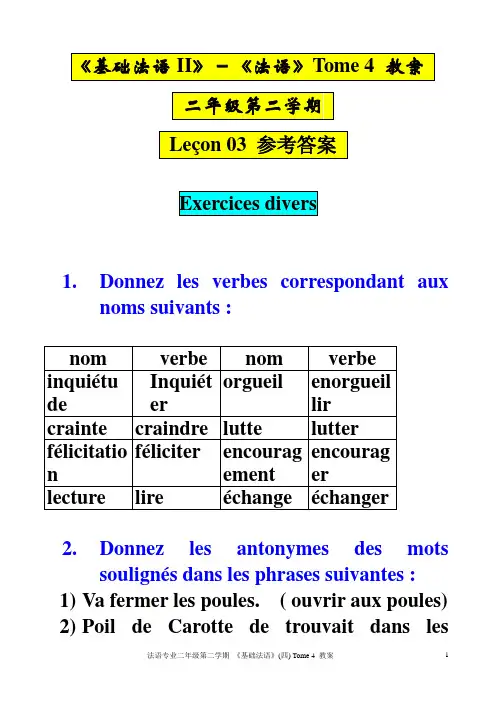
1.Donnez les verbes correspondant auxnoms suivants :2.Donnez les antonymes des motssoulignés dans les phrases suivantes :1)Va fermer les poules. ( ouvrir aux poules)2)Poil de Carotte de trouvait dans lesténèbres. ( dans la lumière)3)Elles continuent à rire. ( cessent de)4)Il a l’air timide. ( hardi / courageux)3.Remplacez les mots soulignés par semettre à, se sauver, presser, se dresser : 1)Poil de Carotte s’est dépêché d’aller fermer les poules. ( s’est pressé)2)Jacques se lève et sort. (se dresse)3)Le garçon commence à rire. ( se met à)4)Le bouc s’enfuit tout de suite. ( se sauve) 4.Transportez les phrases suivantes dudiscours direct au discours indirect :1)Il dit qu’il pleut.2)On annonce que le train va partir.3)Je vous préviens qu’il y a une grève à Roissy- Charles de Gaule.4)Elles disent qu’elles sont fatiguées.5)Si on t’interroge, tu répondras que tu ne sais pas.6)Je dis à Pierre qu’il a oublié de me rapporter le journal.7)L’enfant crie qu’il veut faire un autre tour de manège.8)Elle annonce que ses amis viendront dîner ce soir.9)Vous direz à Cécile qu’elle a laissé ses lunettes chez sa sœur.10)Il me répète souvent qu’il m’emmènera à Venise pour mon anniversaire.5.Transposez les phrases suivantes dudiscours indirect au discours direct :1)Il affirme : «Je ne connais pas cet homme. »2)Le présentateur annonce : «Le film va commencer »3)Christian dit : «J’ai envie d’un bon café. »4)Martine dit : «Ma voiture est en panne. »5)Le vendeur répond au client : «votre commande sera livrée lundi prochain. »6.Transposez les phrases suivantes dudiscours direct au discours indirect :1)Le professeur dit aux étudiants que l’examen aura lieu le 25 mai.2)L’employé répond au voyageur qu’il peut lui réserver une place dans le train de 16h30.3)Les deux touristes expliquent à l’agent de poli ce qu’ils se sont trompés de direction et qu’ils ne savent pas comment rentrer à leur hôtel.4)Nathalie dit à ses parents qu’elle va à la patinoire avec ses amis et qu’elle rentrera vers 7h. Et elle ajoute qu’il y aura une compétition et qu’elle espère bien obtenir un bon classement.5)L’enfant dit à son père qu’il aimerait bien avoir une bicyclette neuve.6)Le directeur du théâtre annonce que l’acteur qui devait jouer le rôle de Ruy Blas est malade et qu’il sera remplacé par M.X.7.Même exercice :1)Les journaux ont annoncé que le présidentde la République allait se rendre prochainement en Italie.2)L’enfant répétait qu’il ne voulait pas aller à l’école.3)Je me suis trompéde numéro, une voix enregistré disait qu’il n’y avait pas d’abonné au numéro que j’avais demandé.4)Les Dumas nous ont répondu qu’ils nous remerciaient de notre invitation et qu’ils acceptaient avec plaisir de venir dîner samedi soir.5)Le professeur a dit aux élèves qu’il leur fallait savoir ce problème par cœur.6)Les enfants ont dit à leur mère qu’ils avaient trouvéun petit chien abandonnédans la rue et qu’ils voudraient le garder. 7)Mon frère m’a dit au téléphone qu’il viendrait me chercher à l’aéroport.8)Le pianiste annonça au public qu’il allait jouer en bis un nocturne de Chopin.9)Amélie m’a écrit qu’elle venait de changer de travail et qu’elle était très contente de son nouveau poste parce qu’elle ferait denombreux déplacements à l’étranger.10)L’expert déclara que ce tableau était un faux.8.même exercices (en modifiant lesexpressions de temps) :1)Mercredi dernier, notre fils Olivier nous a téléphoné d’Algérie qu’il était bien arrivé. Cette semaine, nous avons reçu une lettre de lui nous disant qu’il s’était installé ce jour-làdans la maison que François et lui allaient habiter pendant la durée de leur stage àla raffinerie. Il écrivait également que la veille, le directeur leur avaient fait visiter l’usine et les avaient présentés à quelques cadres de l’entreprise. Enfin il ajoutait qu’ils iraient à la plage le lendemain et qu’ils commenceraient leur travail lundi suivant.2)Charlotte qui suit un cours d’anglais à Oxford a téléphonéla semaine dernière àsa mère. Elle lui a dit qu’elle avait trois heures de cours par jour le matin et quel’après-midi, qu’elle était libre pour travailler ou faire du sport. Elle lui a racontéégalement que le week-end précédent elle était allée à Londres avec des camarades de classe, et qu’ils y retrouveraient le week-end suivant.10. Compréhension rapide :1) b 2) a 3) c 4) c 5) b 6)d 7) c 8)d9)10) c 11) d 12) a1.Transposez les phrases suivantes dudiscours au discours indirect :1)Je me demande où j’ai mis monporte-monnaie.2)Le professeur voulait savoir combien detemps ces étudiants avaient étudiéle français.3)L’étudiant a demandé pourquoi il y avaitun accent circonflexe sur les mots « tête » et « hôpital ».4)Le douanier demande àchaqueautomobiliste s’il a quelque chose à déclarer.5)Mes amis m’ont demandé si je reviendraisles voir à Fontainebleau.6)Il demanda anxieusement s’il n’y avaitvraiment pas d’autre solution.7)Monique a demandé à sa sœur si ellepourrait lui prêter ce roman-làquand elle l’aurait fini.8)Ma belle-mère m’a demandé comment allaient mes parents.9)Je veux savoir qui a téléphonétout àl’heure.10)Le jeune demandait qui voulait faire une partie de poker avec lui.11)Il nous a demandéqui nous préférions, Balzac ou Zola.12)Le père demanda àsa file avec qui elle sortait.13)Tous les gens demandent ce qui a causél’accident.14)Le visiteur cherchait à lire ce qui était écrit sur le panneau.15)Dis moi ce que tu veux faire quand tu seras grand.16)Le serveur demanda à la dame ce qu’elle prendrait comme entré.17)En voyant un paquet sur la table, l’enfant a demandé ce que c’était.18)Il voulait savoir à quoi servait ce bouton rouge.19)L’homme demanda au passant quelleheure il était.20)Ils demandèrent au maître d’hôtel quelvin il leur conseillait avec ce poisson-là. 21)Le client a demandéau garagistelaquelle de ces deux voitures-làconsommait le moins d’essence.22)Mon mari m’a demandé pour lequel deces candidats j’allais voter.plétez les phrases suivantes par unmot interrogatif :1)P ouvez-vous m’expliquer comment on va àla gare de Lyon.2)D ites-nous si cette information est bienexacte !3)T raduis-moi ce qui est écrit sur ceprospectus !4)D ites-moi, s’il vous plaît, où se trouve lastation de métro la plus proche !5)J’aimerais savoir si vous avez deschaussures de sport.6)J e voudrais savoir pourquoi tu n’as pasrépondu à ma lettre.7)J e ne comprends pas qui peut faire cebruit.8)G rand-mère, raconte-nous commentvivaient les gens quand tu étais petite !9)E xpliquez-nous ce qu’il faut faire pourobtenir une carte de travail.10)Personne ne savait s’il reviendrait.(comment, quand, d’où)11)Pouvez-vous me dire qui a peint lesNymphéas.12)Excusez-moi, je n’ai pas compris ce quevous venez de dire.3.Texte à transporter au discours direct :Tante Lucie m’a dit l’autre jour : «mon mari et moi, nous voulons t’offrir un cadeau pour ton mariage. Qu’est-ce que tu désires ? »«Nicolas et moi, nous allons déposer une liste de mariage dans un grand magasin, mais vous pouvez aussi nous faire un cadeau plus personnel. » ai-je répondu.4.Texte à transposez au discours indirect :Un peintre célèbre, retirédans un village de Provence, reçut un jour la visite d’une journaliste. Celle-ci lui demanda tout d’abord pourquoi il avait quitté Paris et ce qui l’avait attiré dans cette région-là.Le peintre répondit que Paris, bien sûr, permettait des rencontres l orsqu’on cherchait à se faire connaître, mais qu’à son âge, on aimait surtout la tranquillité propice au travail. Il ajouta que ce qui lui a plus dans ce pays-là, c’était les couleurs et la qualité de la lumière.La journaliste demanda ensuite s’il se rait possible qu’elle visite son atelier.Le peintre répliqua qu’il le lui ferait visiter bien volontiers parce qu’il était toujours heureux que l’on s’intéresse / s’intéressât à ses œuvres.5.Mettez les verbes entre parenthèses au mode et au temps convenables et relevez lediscours indirect libre s’il y en a :Boum ( un petit garçon de 8 à9 ans) boudait dans sa chambre. On lui avait refusé un troisième petit four, après un dessert copieux de crème et de confiture.-Monsieur Boum ! Votre maman vousappelle.Pauline jeta ces mots dans l’entrebâillement de la porte et disparut. Boum fila le long du corridor. Que voulait sa maman ? Elle n’aurait pas l’audace de lui faire réciter sa table de multiplication, un jour de Pâques ? Serait-ce pour s’informer bien curieux, vraiment, si Boum avait recopié sa dictée ? Il n’était pas rassuré. Des éclats de voix lui prévinrent : son père et sa mère étaient aux prises.«Impossible d’être treize » dit maman.-Il est trop tard pour inviter unquatorzième, dit-papaBoum entra en coup de vent ; son arrivée trancha le différent.-Boum, dit Papa, tu dîneras ce soir àtable pour faire le quatorzième.-Et tu ne mettras pas les coudes sur lanappe.-Et tu ne donneras pas de coup de pied àton voisin, M. Geurd, ni àta voisine,Mme de Falcord.-Boum resta ébloui, comme si la nappe etles cristaux, l’argenterie, les flammes dulustre, l’avaient aveuglé. Puis unimmense orgueil le suréleva.«J’aurai des petits verres comme tout le monde. »-Oui, mais on ne te mettra rien dedans.Ça lui serait égal, du moment qu’il aurait les trois verres par rang de taille.«Je mangerai de tout » suggéra-t-il.-Prudemment, Boum, prudemment. Tun’auras pas de poisson parce qu’il y abeaucoup s’arrêtes, et pas d’asperges,parce que ça t’échauffe. Ne demandepas de foie gra non plus, c’est troplourd.-Oh ! Maman !6.Version :一个不吉利的日子我先是排队等车。
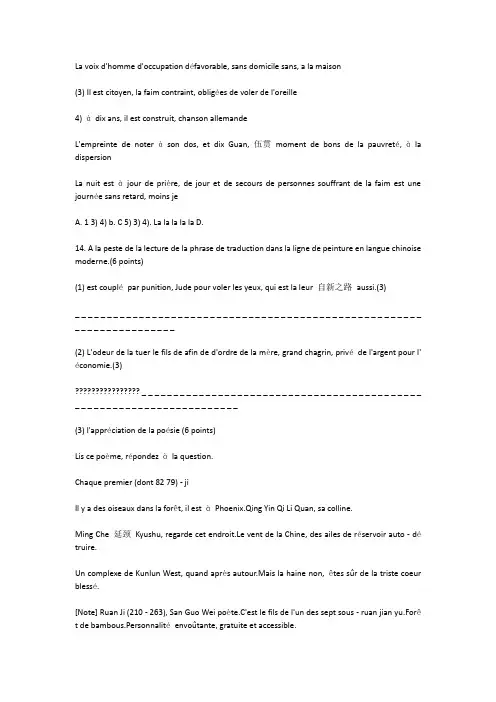
La voix d'homme d'occupation défavorable, sans domicile sans, a la maison(3) Il est citoyen, la faim contraint, obligées de voler de l'oreille4) àdix ans, il est construit, chanson allemandeL'empreinte de noter àson dos, et dix Guan, 伍贯moment de bons de la pauvreté, àla dispersionLa nuit est àjour de prière, de jour et de secours de personnes souffrant de la faim est une journée sans retard, moins jeA. 1 3) 4) b. C 5) 3) 4). La la la la la D.14. A la peste de la lecture de la phrase de traduction dans la ligne de peinture en langue chinoise moderne.(6 points)(1) est couplépar punition, Jude pour voler les yeux, qui est la leur 自新之路aussi.(3)_ _ _ _ _ _ _ _ _ _ _ _ _ _ _ _ _ _ _ _ _ _ _ _ _ _ _ _ _ _ _ _ _ _ _ _ _ _ _ _ _ _ _ _ _ _ _ _ _ _ _ _ _ _ _ _ _ _ _ _ _ _ _ _ _ _ _ _ _ _(2) L'odeur de la tuer le fils de afin de d'ordre de la mère, grand chagrin, privéde l'argent pour l'économie.(3)???????????????? _ _ _ _ _ _ _ _ _ _ _ _ _ _ _ _ _ _ _ _ _ _ _ _ _ _ _ _ _ _ _ _ _ _ _ _ _ _ _ _ _ _ _ _ _ _ _ _ _ _ _ _ _ _ _ _ _ _ _ _ _ _ _ _ _ _ _ _ _ _(3) l'appréciation de la poésie (6 points)Lis ce poème, répondez àla question.Chaque premier (dont 82 79) - jiIl y a des oiseaux dans la forêt, il est àPhoenix.Qing Yin Qi Li Quan, sa colline.Ming Che 延颈Kyushu, regarde cet endroit.Le vent de la Chine, des ailes de réservoir auto - détruire.Un complexe de Kunlun West, quand après autour.Mais la haine non, êtes sûr de la triste coeur blessé.[Note] Ruan Ji (210 - 263), San Guo Wei poète.C'est le fils de l'un des sept sous - ruan jian yu.Forêt de bambous.Personnalitéenvoûtante, gratuite et accessible.(1) Le vent: en automne.II s êtes sûr (Li - NG): triste.15. Le poème "de la dynastie Qing Yin Qi Li Quan, sa colline.Ming Che de Kyushu, regarde cet endroit 延颈"quatrième phrase reflète le caractère Phoenix"?(2 points)16. Ce poème sur l'ensemble de l'expression de l'expression de ce que, quel genre de sentiments?Faites une analyse succincte.(4)Quatrièmement, lire le texte ci - dessous, l'achèvement de la question 17 à20 (20%)Le chien.AvecLe chien drogué, sac souvent semblant de salope, professeur de la classe: "Jung, Pourquoi laisser la poire?" La salope préventive a répondu: "Ouaf Ouaf Ouaf.Whoa! "C'est quand les gens manger difficile, pas de chien, le chien au moment de tempérament très doux, maigre, marche le long de la paroi est glissé, doucement, il n'y a pas eu de Lang appelé; pisser aussi paresseux de la jambe; humble amicale, qui a appeléqui, indépendamment de leur statut social, ne regardez pas l'identité, va te quand le maître.Timidement près de toi, et elle s'est, une queue attache plus les yeux en secret pour vous envoyer Mei couleur! Très flatteur, lécher la Languette tiède de vos mains, comme la petite - fille aussi attentive.Plus tard, un adulte que le chien est en communication avec le personnel.Et de la culture chinoise sur les histoires de chiens beaucoup:., 狗彘不如, cocorico, un homme brisé, chien de chiens dans le gaz, des chiens, des chiens dioica, chien...Nom de chien qui n'a pas de caractère collant! Si, qui ose et le chien est presque? De fraterniser tire mec? Il semble que faire un chien vraiment très confus.Au cours de ces dernières années, mais le chien en vogue.Le chien a un brillant de changements.Le chien de l'ouverture de dépasser l'élan àla croissance de la population.Les chiens de la famille doit revenir de magasins, prix incroyable! Le chien de l'hôpital, le chien, le chien de l'Association, ce magasin de propagation citer, certains ont eu comme Biggie, star de large.Près de Bao Xiang Cun, une tête de chien en tournée avec son front, arrogant, le caractère très impopulaire, ouverture de rugir Sapo, n'a rien àdire.Pisser le carrefour de choisir animé, une jambe triomphantes, Majestic merde ne doit pas manger, dans le village de chanter comme un appel àmoins de bruit.Les portes fermées.Demandéde frapper àla porte, personne n'a pas la langue, mais un chien appelémerveilleusement! Le maître porte, alors ça fait plus mal, une chaîne tendue la tige d'acier ordinaire, c'est généralement la courtoisie.Vos voisins, la porte crie: "il y a le chien?" C'est pour le "quelqu'un?" C'est ironique.Tout le monde est rarement des échanges, plus le mur de plus haute barrière, chiens de plus en plus dormir la nuit, mais également àfaire des nuit est devenu une écorce du monde, de lanervosité, panique, un chien chien un écho acoustique, millions! Les chiens aboient critiques; nuit a perdu son élimination, la lune claire, mais l'homme le plus serré.Nouvelle - Cours - standard - un - un - netLe chien de la publicité, n'est - ce pas la dépréciation de la valeur auto -? Est le coeur est trop loin? Est incapable de communiquer, même le coeur aussi vrai! Tenir un chien.Regarde, d'autres ne peuvent pas entrer.Chacun de garder une partie de ciel bleu, saisons de chauffage et de refroidissement auto - est différent, le monde est grand mais de laisser les chiens de la famille et le séparatisme en morceaux au cachot! Même le chien lui - même mettre en prison, une chaîne, un bassin de nourriture pour chien un nid de séjour.Il ne peut sortir de la porte de la prison.Avant - hier a conduit àhuit Li Ping Cun, mais rarement vu le chien de montagne la montagne, près de la maison, les étrangers de crier: "le chien?" maître, mais dans un autre colline a répondu: "no yo! - aller boire!" pousser la porte, bien sûr, pas de chien.Parfois, quand un chien, mais très poli, renifler tu es.Et puis tourner vers les buissons pour attraper des papillons.àl'extérieur de la montagne sapotacées très appropriéàles gaz, Lam murmure dans la perception de la couleur, une relation harmonieuse entre l'homme et la ngue puis Lang: mourir ici! Dit de rentrer le chien tous tués, cuits, de manger, de se libérer.C'est de la merde! ça alors, pas de chiens comment? C'est nécessaire, mais il est aussi triste eux - mêmes.17. Le chien est la classe du personnel, selon l'auteur, la disposition du passéde chiens et de ces dernières années de chien est différenciée, s'il vous plaît, respectivement indique les caractéristiques de quoi est passéde chiens et de ces chiens.(4)Ces chiens?????????????: (2 points)Au cours de ces dernières années de chien: (2 points)18. Le quatrième segment est écrit "vos voisins, la porte crie:" il y a des chiens? 'C'est pour le "quelqu'un?" est simplement ironique ".(8 points)(1) crier "quelqu'un?", reflète psychologique appeléyéménites? Reflète des relations interpersonnelles? (3 points)(2) àcrier "chien", et reflète psychologique appeléyéménites? Reflète des relations interpersonnelles? (3 points)(3) la demande de chiens et de demander àquelqu'un de contraste? (2 points)Réponse: (1)(2)(3)19. Lire le dernier paragraphe de l'article: (4%)(1) la fin de "tel est le monde, pas de chien?" dans la même phrase, "le monde" désigne une situation sociale? (2 points)(2) ce paragraphe dans le texte intégral de la structure, un rôle important dans l'expression de l'auteur de pensées et sentiments? A? (2 points)Réponse: (1)(2)Le juge, juste deux: () () (4)。
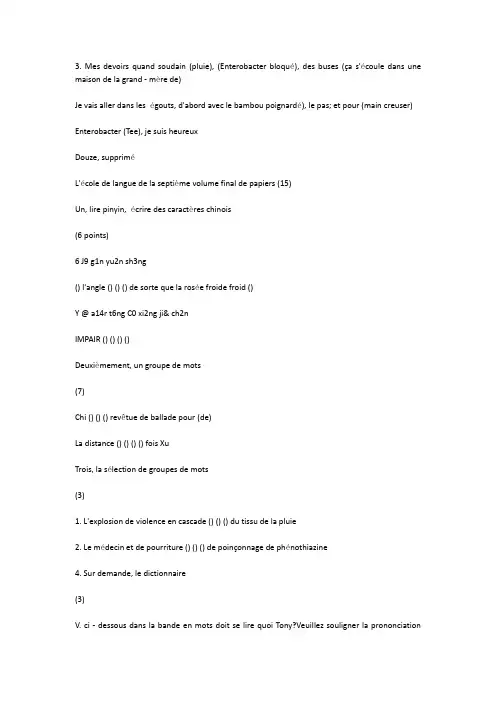
3. Mes devoirs quand soudain (pluie), (Enterobacter bloqué), des buses (ça s'écoule dans une maison de la grand - mère de)Je vais aller dans les égouts, d'abord avec le bambou poignardé), le pas; et pour (main creuser)Enterobacter (Tee), je suis heureuxDouze, suppriméL'école de langue de la septième volume final de papiers (15)Un, lire pinyin, écrire des caractères chinois(6 points)6 J9 g1n yu2n sh3ng() l'angle () () () de sorte que la rosée froide froid ()Y @ a14r t6ng C0 xi2ng ji& ch2nIMPAIR () () () ()Deuxièmement, un groupe de mots(7)Chi () () () revêtue de ballade pour (de)La distance () () () () fois XuTrois, la sélection de groupes de mots(3)1. L'explosion de violence en cascade () () () du tissu de la pluie2. Le médecin et de pourriture () () () de poinçonnage de phénothiazine4. Sur demande, le dictionnaire(3)V. ci - dessous dans la bande en mots doit se lire quoi Tony?Veuillez souligner la prononciationcorrecte dans de la peinture(2 points)Sixièmement, les mots suivants complète(2 points)Tout Dieu () Note secouépour () 7 transversalement () 8 Mesh ne tourne pas ()Sept, remplir les blancs.(3)1. Papa n'a pas fini le travail hier (SEC)(durée continue)2. L'esprit de Lei Feng oncle ne nous avance)(encourager la motivation)3. Si les vagues de plus sur la surface de la mer, le fond de la mer est toujours très ()(la paix calme)Chaque groupe de huit, de trouver les réponses appropriées, en dessous de tracer une ligne (2 points)1. Le livre sur l'étagère (livre est sur l'étagère)Le manuel sur le stylo de la papeterie, les étudiants de sac2. Les branches de l'arbre (arbre est un arbre)Le corps de tête de la jambe le pied sur la mainNeuf, la détermination de la réponse correcte, de jouer à"√dans les parenthèses"(5 points)1. Avec un peu de mots choisis la explication?2. Qu'est - ce que ça veut dire ces phrases?。
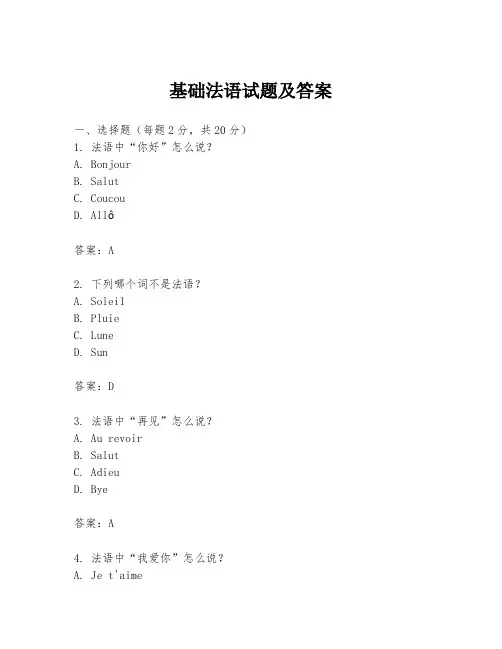
基础法语试题及答案一、选择题(每题2分,共20分)1. 法语中“你好”怎么说?A. BonjourB. SalutC. CoucouD. Allô答案:A2. 下列哪个词不是法语?A. SoleilB. PluieC. LuneD. Sun答案:D3. 法语中“再见”怎么说?A. Au revoirB. SalutC. AdieuD. Bye答案:A4. 法语中“我爱你”怎么说?A. Je t'aimeB. Je t'adoreC. Je t'apprécieD. Je t'aime beaucoup答案:A5. 下列哪个词是复数形式?A. ChatB. ChienC. ChatsD. Chiennes答案:C6. 法语中“谢谢”怎么说?A. MerciB. S'il vous plaîtC. Excusez-moiD. Pardon答案:A7. 下列哪个词是动词?A. TableB. ChaiseC. LireD. Voiture答案:C8. 法语中“你叫什么名字?”怎么说?A. Comment tu t'appelles?B. Comment vous appelez-vous?C. Quel est votre nom?D. Comment vous appelez-vous? 答案:B9. 法语中“我喜欢音乐”怎么说?A. J'aime la musiqueB. Je déteste la musiqueC. Je n'aime pas la musiqueD. Je n'aime rien à la musique 答案:A10. 下列哪个词是形容词?A. BleuB. VertC. RougeD. Tous les trois答案:D二、填空题(每题2分,共20分)1. 法语中“书”是______。
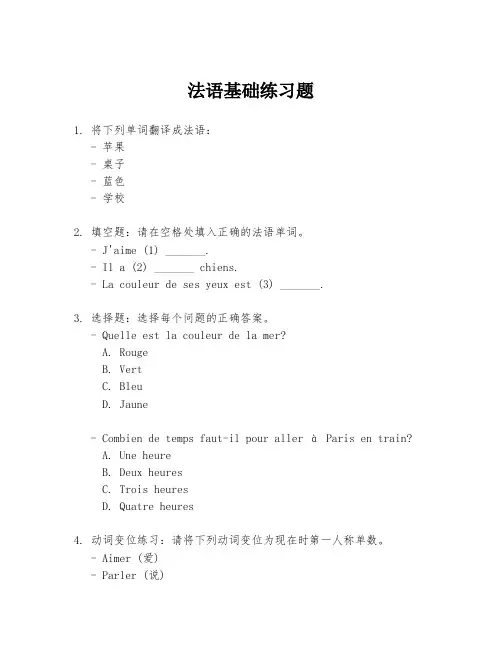
法语基础练习题1. 将下列单词翻译成法语:- 苹果- 桌子- 蓝色- 学校2. 填空题:请在空格处填入正确的法语单词。
- J'aime (1) _______.- Il a (2) _______ chiens.- La couleur de ses yeux est (3) _______.3. 选择题:选择每个问题的正确答案。
- Quelle est la couleur de la mer?A. RougeB. VertC. BleuD. Jaune- Combien de temps faut-il pour aller à Paris en train?A. Une heureB. Deux heuresC. Trois heuresD. Quatre heures4. 动词变位练习:请将下列动词变位为现在时第一人称单数。
- Aimer (爱)- Parler (说)- Manger (吃)- Écrire (写)5. 阅读理解:阅读下面的短文,并回答以下问题。
- 短文内容:(此处省略短文内容)- 问题1:主人公的名字是什么?- 问题2:主人公去了哪里?- 问题3:主人公做了什么?6. 写作练习:请写一篇不少于80字的短文,描述你最喜欢的季节及其原因。
7. 听力理解:听录音材料,完成以下任务。
- 任务1:记录对话中提到的所有地点。
- 任务2:总结对话的主要内容。
8. 语法填空:请在空格处填入正确的法语语法结构。
- Je (1) _______ à la gare à 8h du matin.- Elle (2) _______ à la bibliothèque depuis deux heures. - Nous (3) _______ au parc pour jouer au football.9. 翻译句子:将下列句子翻译成法语。
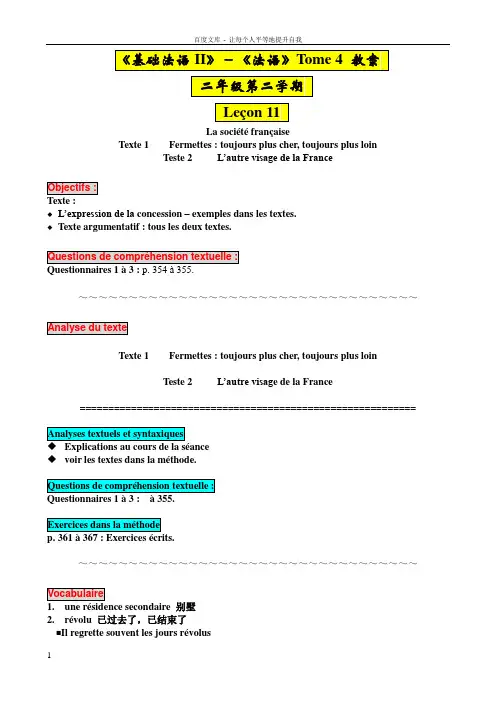
La société françaiseTexte 1 Fermettes : toujours plus cher, toujours plus loinTeste 2 L’autre visage de la France◆L’expression de la concession – exemples dans les textes.◆Texte argumentatif : tous les deux textes.~~~~~~~~~~~~~~~~~~~~~~~~~~~~~~~~~~Texte 1 Fermettes : toujours plus cher, toujours plus loinTeste 2 L’autre visag e de la France===========================================================ance◆voir les textes dans la méthode.~~~~~~~~~~~~~~~~~~~~~~~~~~~~~~~~~~别墅2. révolu 已过去了,已结束了⏹Il regrette souvent les jours révolus⏹Le temps est révolu où on pourrait manger à la cantine gratuitement.3. correct adj. 中等的,过得去的⏹Par rapport au prix, la cuisine de notre cantine est correcte4. la crise économique 经济危机5. engouement 热中,迷恋⏹Son engouement pour le foot l’a poussé à créer un club de foot.6. se démentir 1)自相矛盾2)停止,中断,变卦⏹Il se dément lui-même à tout propos.⏹Mon amitié pour vous ne s’est jamais démenti.⏹L’irrésistible engouement des Français pour la moindre bergerie cévenole ou le plus modeste mas provençal ne se dément pas.7. autant + inf. 也好,也一样⏹Il fait très froid, autant rester chez soi.⏹Ce n’est pas loin, autant y aller à pied.8. se mêler de 介入,插手⏹Mêlez-vous de vos affaire !⏹Un pays ne doit pas se mêler des prooblèmes de politique intérieur d’un autre pays.9. battre un record 打破记录10. la folie疯狂, faire une folie 破费⏹Les prix des maison sont en folie maintenant.⏹Ils ont fait une folie en achetant cette voiture.11. piller . 1)抢劫⏹Ces bandits ont pillé des voitures.⏹2) 侵吞,挪用⏹Ce comptable est condamné à 10 ans de prison pour avoir pillé des fonds publics.⏹3)抄袭,剽窃⏹Il a pillé un auteur français.12. déplorer⏹déplorer la mort de qqn. 痛惜某人的去世⏹Je déplore son échec. 我为他的失败感到惋惜。
1.traduisez en français(1)C’était le meilleur filmqu’il eût vu l’annéedernière.(2)Hier, je doutais encores’il eût réussi.(3)A ce moment-là, je necroyais pas que l’hommepuisse aller sur la lune. (4)Si Anquetil ne s’était pas régulièrement entraîné, il n’eût / n’aurait pas pu gagné5 fois le Tour de France.2.Dites le sens des noms d’action suivants et donnez les verbes correspondants :Conversation est l’action du verbe converser. Impression est l’action du verbe impressionner. Etonnement est l’action du verbe étonner.Divulgation est l’action du verbe divulguer.Citation est l’action du verbe citer.Exclamation est l’action du verbe exclamer.Existence : fait d’exister Promenade : action de promenerIndication : action d’indiquer Admiration : action d’admirerEtude : activitéintellectuelle par laquelle on s’applique à apprendre, àconnaître. V : étudierJouissance : fait de jouir de qch, d’en avoir l’usage, la possession, le profit.3.Remplacez les points par chercher ou trouver (retrouver) :1)Je suis allé hier chez luisans le trouver.2)« Ah !»vous voilàenfin, je vous ai cherché partout.3)Cherchez la solution de ce problème, vous la trouverez.4)Est-ce que vous trouvezcette règle difficile ? 5)C’est Jacques qui atrouvéle stylo quej’avais cherche.6)Les ingénieurscherchent à moderniserla production.7)Le système dont il se servait pour souligner lui permettait de retrouver facilement le passage.8)Il a trouvésans difficultéle livre dont il avait besoin.4.Traduisez les phrases suivantes en indiquant les différents sens du verbe connaître :1)我认识从这儿出去的那个男孩,他是看门人的孩子,2)你熟悉里昂这座城市吗?3)这是个精通本职工作的人。
plétez le tableau suivant :2.Veuillez préciser le sens du mot fin :1)le fin mot : la vérité. ex : le fin mot d’uneaffaire ( 内情,底细)2)des pierres fines (affiné) 宝石3)un dîner fin ( délicat, raffiné) 精美的晚餐4)avoir le nez fin (délié, subtil) 嗅觉灵敏5)il n’est pas très fin (malin) 他不太机灵6)une pluie fine ( petite) 毛毛细雨7)un visage fin ( contraire de rond et plein)清秀的面孔8)les plus fines nuances de la pensée (délicate)思想上的细微差异9)le fin du fin (le meilleur) 精华10)jouer au plus fin ( intelligence) 斗智3.Traduisez les mots et expressions suivantesen chinois :1)une couleur délicate 浅色2)une sculpture délicate 精细的雕刻3)la peau délicate du bébé婴儿娇嫩的皮肤4)une plante délicate 娇弱的植物5)une situation délicate 微妙的处境6)une différence délicate 微妙的差别7)une question délicate 一个棘手的问题8)une oreille délicate 灵敏的耳朵9)il est trop délicat sur la nourriture 他很挑食10)des attentions délicates 无微不至的关怀4. Complétez en choisissant l’expression convenable.1)prendre congé ou prendre un congé ?(1)Il est en vacances, il prend un congé dedix jours.(2)Je ne voulais pas partir sans prendrecongé de vous2)ouvrir l’œil ou ouvrir un œil ?(1)Je me suis réveillé, j’ai ouvert un œil ,j’ai vu qu’il pleuvait alors je me suisrendormi.(2)C’est une région très d angereuse, ilfaudra ouvrir l’œil.3)prendre de l’assurance(有信心) ouprendre une assurance(买保险) ?(1)Il est de plus en plus sûr de lui, ilprend de l’assurance.(2)Par prudence, j’ai pris une assurancetous risques(一切险的保险)4)rendre compte ou rendre des comptes (àqn) (有义务向某人汇报工作)(1)Quand on m’a volé mon portefeuille,je ne me suis rendu compte de rien.(2)C’est elle qui vous emploi, c’est donc àelle que vous devez rendre des comptes.5) fermer une (ou la) porte ou fermer la porte à quelqu’un ?(1)Il fait froid, ferme la porte s’il vousplaît !(2)C’est un individu malhonnête e t je luiai fermé la porte depuis longtemps.5. Reliez les adverbes qui s’opposent : 1)une chapelle a éténouvellementreconstruit sur ce site ( anciennement) 2)On emploie rarement cette expression.( fréquemment)3)Il nous a répondu aimablement.( sèchement)4)Elle s’est mise à travailler énergiquement.(mollement)5)Ils se sont conduit bravement ;(lâchement)6. Récrivez les phrases en utilisant un verbe ouune expression synonymes :1)Personne ne vous oblige àaccepter cetteproposition, vous pouvez la refusez.2)Quand vous fermez la porte, faitesattention àne pas laisser les clés àl’intérieur.3)Il est tard nous devons vous dire au revoir.4)Quand il est parti, tout le monde l’ignorait.Maintenant qu’il est revenu fortune faite, il est bien reçu partout.7.Cherchez l’adjectif en –aire, dérivédu nom italique. Par quel adjectif peut-on qualifier ? 1) un mur qui date de plusieurs siècles, ( un mur séculaire)2) une femme qui a beaucoup d’autorité (une femme autoritaire)3) un événement qui ressemble à un spectacle ( un événement spectaculaire)4) un problème qu’on juge de seconde importance ( un problème secondaire) 5) un budget qui présente un déficit ( un budget déficitaire)6) une émission qu’on peut voir toutes les semaines (une émission hebdomadaire)11. Compréhension rapide :1. c2. b3. b4. d5. a6. d7. c8. bplétez les phrases suivantes :1)Ces 30 kilomètres à pied m’ont tellementfatigué que je vais me coucher !2)Elle a tant de livres qu’elle ne sait plus oùles ranger.3)Il a tellement insisté qu’il a fini par obtenirce qu’il voulait.4)La fenêtre a claquési violemment qu’uncarreau s’est cassé.5)Les enfants font un tel bruit que jen’arrive pas à travailler.6)Rémy a passéune nuit blanche ; il est sifatigué qu’il dort debout.7)Ce chocolat était si chaud que je me suisbrûlé en le buvant.8)En France, il y a tant de fromages qu’onne peut pas tous les connaître.9)Cet endroit est si agréable qu’on aimeraity passer des vacances.10)Ce garagiste a tant de travail qu’ildevrait engager un deuxième mécanicien.plétez les phrases suivantes :1)Jérôme et Sylvie aiment tellement lecinéma qu’ils vont au cinéma deux fois par semaine.2)E mmanuelle était si jolie que tout lemonde l’aime.3)N ous avions oublié de fermer les fenêtres,si bien que les voleurs a volé mon appareil photo qui était posé sur le bureau.4)C es deux élèves bavardaient tant qu’ilsn’ont pas entendu ce que le professeur parlait.5)L e mois dernier, j’ai eu un tel travail quetout le monde m’e nvie et qu’on me prend pour chançard.6)I l y avait tant de monde à la banque qu’ona dû attendre pour longtemps.7)L’enfant a eu si peut qu’il n’ose pas sortir.8)I l y a un tel brouillard qu’on ne voit pasbien.3.Mettez le verbe entre parenthèses au mode etau temps convenables :1)Pascal avait beaucoup de fièvre, si bienque sa mère a appelé le médecin.2)Il parle français avec un fort accent, sibien qu’on le comprend mal.3)La végétation a envahi ce jardinabandonné de sorte qu’on ne peut plus yentrer.4)Le TGV est un train très rapide, si bienque vous seriez à Dijon avant midi, et quenous pourrions déjeuner ensemble.5)Il y a eu un coup d’Etat, de sorte qu’on aévacué tous les ressortissants étrangers.6)La Joconde est un tableau si célèbre quetous les touristes veulent le voir.7)Cette nuit, le vent a soufflé tellement fortque plusieurs arbres ont été déracinés. 8)Nos voisins écoutent de la musique si tardqu’ils nous empêchent de dormir.9)La circulation dans Paris est parfoistellement difficile qu’il vaut mieux prendre le métro.10)Vous fumez tant qu’un jour voustomberez malade.11)Mon fils a tellement grandi qu’il ne peutplus mettre ce blouson.12)La main du vieux monsieur tremblaittellement qu’il a renversé son café sur son pantalon.13)Il nous a raconté tellement d’histoiredrôle que nous en étions malades de rire.14)Nous avons pris tant de photos pendantnotre voyage en Sicile que nous ne pourrions pas vous les montrer toutes ce soir.15)Bonaparte avait une telle ambition qu’ildevint empereur.16)Cette entreprise a de telles difficultésfinancières qu’elle devra licencier une partie de son personnel.17)Cette année-là, il fit un tel froid que leGrand Canal de Versailles gela.4.Mettez le verbe entre parenthèses au mode etau temps convenables :1)I l vaut mieux que vous preniez deschèques de voyage pour aller à l’étranger.2)J e sais que vous ne me croyez pas, maisc’est pourtant la vérité.3)M. Merlin a téléphoné et il demande quevous le rappeliez.4)J’ai l’impression que vous n’avez pas biencompris ce que je viens de dire.5)L a banque a acceptéque nousremboursions notre prêt en dix mensualités.6)J e souhaite que vous fassiez un bonvoyage.7)J’ai beaucoup de travail cette semaine ;j’aimerais mieux que tu viennes dîner la semaine prochaine.8)I l y avait beaucoup d’embouteillages ;j’avais peur que nous n’arrivions en retard à l’Opéra.9)J e n’ai plus que 50 francs dans monporte-monnaie ; je croyais qu’il me restait au moins 100 francs.10)Nous parents voulaient que nousfassions du sport et que nous jouions d’un instrument de musique.5.Mettez une conjonction ou un adjectif convenable dans les subordonnées de conséquence ci-dessous :1)Le malade était trop affaibli pour qu’ilcomprenne ce qui se passait.2)Les cambrioleurs causaient en marchantvers la rivière de sore qu’ ils se trouvèrent bientôt près d’un po nt.3)Le bijoutier a tant pleuré qu’il a fini pardevenir aveugle.4)Notre professeur est malade, donc il neviendra pas ce soir.5)Les belles pierres précieuses sont tellementfines que nous sommes ravis d’admirer.6)Le voleur est entré dans l’arrière-boutiquesans que personne le sache.7)Elle se masque, de façon que personne nepeut la reconnaître.8)Il se mit àpleuvoir, aussi eut-on hâte derentrer.9)Le commissaire et le bijoutier onttellement bavardé qu’ils ont oublié l’heure de déjeuner.6.Tournez les phrases suivantes de manière qu’elles contiennent chacune une proposition subordonnée de conséquence :1)Etes-vous si sûr que vous ne vous trompezjamais.(Votre jugement est-il tellement sûr que vous ne vous trompiez jamais ?)2)Cet étudiant est si (tellement)bon que toutle monde l’aime.3)Le temps est précieux, si bien que nousn’avons pas une minute à perdre.4)L’enfant a crié si fort que la mère estaccourue tout de suite. (L’enfant a crié bien fort, de sorte que la mère est accourue tout de suite)5)L’émotion des spectate urs est tellementgrande que leurs yeux se remplissent de larmes.6)Le maître leur a imposé silence d’un tonsévère, de sorte que les enfants se sont tus tout de suite.7)Dans la classe, il y avait un tel bruit qu’onl’entendait jusque dans la cour.8)Dans l’ate lier, les machines faisaient unsi grand bruit que nous ne pouvions rien entendre.9)Sa mémoire est si bonne qu’il n’oubliejamais rien.10)Il est si faible que, souvent la tête luitourne, lorsqu’il se lève.7.Version :窃贼原来是经理让·保尔,50岁,勤劳能干,对员工要求严格,甚至一点情面都不讲,身为贝尚松新兴百货连锁商店的经理他很是以身作则。
法语学习基础练习题100句法语学习基础练习题100句法语学习基础练习题100句1. Bonjour, comment ca va ? Ca va bien, et toi ?2. Comment t’appelles-tu ?3. Comment vous appelez-vous ?4. Je m’appelle ________ et toi ?5. Enchante6. Ca me fait plaisir de te/vous rencontrer7. Ca me fait plaisir de te/vous connaitre.8. Je me presente.9. Je suis chinois (e) Je suis canadien(ne)10. Je parle chinois, je parle francais11. Je viens de Chine. Je viens du Canada.12. Tu parles chinois ?13. Tu viens du Canada ? Non, je viens de Chine14. Tu es canadien ? Non, je suis chinois15. Tu t’appelles __________ ? Non, je m’appelle ___________16. Vous parlez chinois ? Oui, je parle chinois Non, je parle francais17. Vous etes chinois ? Oui, je suis chinois. Non, je suis canadien (ne)18. Vous venez de Chine ?19. Vous vous appelez- comment ?20. Levez-vous ?21. Assoyez-vous ?22. Prenez votre cahier.23. Ecrivez dans votre cahier.24. Ouvrez votre cahier d’exercices25. Fermez votre c ahier d’exercices26. Ouvrez la fenetre, il fait chaud.27. Fermez la fenetre, il fait froid28. Montrez-moi le dictionnaire29. Ecrivez votre nom au tableau30. Effacez votre nom31. Montrez-moi le tableau32. J’habite a Xiamen. (ville)33. Tu habites a Xiamen ?34. Vous habitez a Xiamen ?35. Je suis etudiant (e)36. Tu es etudiant (e) ? Non, je suis ________________37. Vous etes etudiant (e) ? Oui, je suis etudiante.38. J’ai _____ans.39. Quel age tu as ?40. Quel age as-tu ?41. Quel age vous avez ?42. Quel age avez-vous ?43. J’ai ________ans44. J’ai ______enfant(s) ?45. Tu as des enfants ?46. Vous avez-des enfants ?47. J’ai un garcon, j’ai une fille48. Comment s’appelle-t-elle ?49. Comment s’appelle-t-il ?50. Elle s’appelle__________.51. Il s’appelle___________52. Elle s’appelle comment ?53. Il s’appelle comment ?54. Tu viens-d’ou ?55. Vous venez-d’ou ?56. C’est quoi ton nom ?57. Quel est ton nom ?58. C’est quoi ta/votre nationalite ?59. Quelle est ta/votre nationalite ?60. Quelle langue tu parles ?61. Quelle langue vous parlez ?62. C’est quoi ta/votre langue ?63. Tu es marie ?64. Vous etes marie ?65. Oui, je suis marie ?66. Non, je suis celibataire.67. Ou habites-tu ?68. Ou habitez-vous ?69. Vous habitez ou ?70. Tu habites ou ?71. Ou tu demeures ?72. Tu demeures ou ?73. Ou tu restes ?74. Tu restes ou ?75. Vous restez ou ?76. Ou vous restez ?77. Avez-vous des enfants ?78. As-tu des enfants ?79. Combien d’enfants tu as ?80. Combien d’enfants avez-vous ?81. J’ai un garcon. J’ai un fils. J’ai une fille.82. Qu’est-ce que tu fais comme travail ?83. Qu’est-ce que vous faites comme travail ?84. Ton fils, il a quel age ? Quel age il a ton fils ?85. Ta fille, elle a quel age ? Quel age elle a ta fille ?86. Quel age ils ont tes enfants ? tes enfants, ils ont quel age ?87. As-tu des freres ?88. As-tu des soeurs ?89. Comment s’appellent-ils ? Comment s’appellent--elles ?90. Comment s’appelle-t-il ? Comment s’appelle-t-elle ?91. Ta soeur, elle est mariee ? Oui, elle est mariee.92. Ton frere, il est marie ? Non, il est celibataire.93. Ta soeur, elle a des enfants ? Oui, elle a ______94. Ton frere, il a des enfants ? Oui, il a ____ non.95. Combien d’enfants il a ton frere ? Il a _________96. Combien d’enfants elle a t a soeur ? Elle a ______97. Ton frere, ou il habite ? Il habite a ____________98. Ta soeur, ou elle demeure ? Elle habite a ________99. Ta soeur, elle parle francais ? Non, elle parle________100. Ton frere, il parle francais ? Non, il parle _______[1][2][3]。
2, deux d'entre eux sont des élèves de notre classe.3, un changement de cette montagne, pour nous, est très bien.4, nous ne devrions pas accuser quelqu'un d'autre et de se défendre.5, vu l'examen de quelques jours, il déteste manger ni dormir, 24 heures sur 24 dans le nez de l'apprentissage.6, nous avons dû admirer Guan Hanqing dans plus de 700 ans sur scène pour nous de créer une telle femme de brillance de l'image.Quatrièmement, l'analyse (35%)1, avec le niveau d'analyse, procédéd'analyse de phrases ci - dessous, et que sa structure fonctionnelle.(9)(1) un idéal comme de jeunesLes yeux de sourcils longs II épais et une paire de taille moyenneUn objectif de la Division est l'utilisation de mots de raconter des mots2, l'analyse ci - dessous des phrases, et indique que la petite classe.(6 points)(1) la porte une prise de photo.(2) camarade Zhang, s'il vous plaît, n'oubliez pas de prendre un parapluie.(3) je, vous n'avez pas confiance?Analyse de 10, la phrase suivante est simple ou complexe, ou de la contraction de la phrase est l'élément de syntaxe; division simple phrase, est composéde clauses indiquant la relation entre l'analyse de niveaux multiples, est complexe et indiquer la relation.(12)1) Toute personne qui doivent apprendre de la science et de la culture.Il a pris le livre.Il a de la famille àl'hôpital de blessure guérir.Il doit être àla persévérance de notre ami, l'expérience comme consultants, afin que le gardien.Et je salue le peuplier car non seulement il symbolise les agriculteurs du Nord, en particulier le symbole que notre lutte de libération nationale est indispensable, fort, ainsi que de l'esprit àprogresser.11, l'analyse de la déclaration ci - dessous àl'aide de quelle rhétorique.(8 points)(1) Il y a une piste, pour un bateau l'amertume.2) La brise, des brins de parfum, le chant que lointain tour comme ça.3) "Kung, ton visage et des cicatrices sur!"Et ici, le ciel bleu clair de lune, chauve, montagne, monotone de loess, de l'eau est profonde, lai, semble être la plus appropriée de fond, sans être remplaçable.V. Résumé(15%)1, par exemple la différence métonymie et la métaphore.2, par exemple "Ba" caractéristiques.1, par exemple, qu'est - ce que des motifs de phrase et la classe.2, la nature brièvement la grammaire.3, complexe et la phrase, quelle est la différence?Troisièmement, par exemple le projet du pinyin chinois mandarin syllabe y, W dans l'utilisation des dispositions spécifiques qui, quel est le rôle de ces dispositions?(15)IV, par exemple les conditions Mandarin voyelle / I / principaux allophones et ces variants apparaissent (10%)Cinq, quel est le sens?Quelles sont les propriétés de sens?(10)Six, s'il vous plaît, analyse le type de structure de la mention suivante (10%)Exemple: convaincre (complément de type composéde mots)Avion () () () seulement faible percée ()() () est confinépar la disparition non () ()() Le calmeSept, par exemple le changement lexicale dans quels domaines (10%)Huit, par exemple des normes modernes de classification de mots chinois (15%)。
Mais maintenant je sens l'enseignement ()Ose et contraire àl'homme comme ()Des hommes aussi il ne revient jamais! "()Le roi de Qin également aller (colonne)Fonds de financement des macro - fille ()Yan Cheng Wei de résonance de vibration (roi).La figure la dague de pauvres (voir)La Chambre de l'épée, l'épée longue, putain de sa chambre () Chao Chao non pas ()Le roi de Qin complexe par le Ke, par huit invasive ()3. Des parties de discours1. Des soldats du Nord supprimé().2. La lettre e ().3. Xie Yue (avant).4. 樊於avant la période mais dit ().5. Avant gauche et droite ().6. La personne plus loin ().7. Rendre pour sentir le roi ().8. Le Prince Chi - zhi ().9. Toute sur des couronnes ().10. Les courtisans étrange ().11. A occupéàgronder dit ().12. A icunshe du fleuve Yi ().13. Mais pour les étudiants de vol ().4. Les homonymes1. Le regard qui soupire rhinorrhéeT, le sens: justice, aujourd'hui.2. Le général fan de la pauvretéva danLa pauvreté, le sens de la justice::, aujourd'hui.3. Dan ne supporte pas d'être àvotre privée, mais les blessures chez les personnes âgées Les personnes âgées, au sens de la justice::, aujourd'hui.4. Le général n'délibérémentEn Italie, au sens de la justice::, aujourd'hui.5. Lors de la rencontre de Qin général, est profond!Dans le sens de la justice, aujourd'hui,::.Profond, au sens de la justice::, aujourd'hui.6. Le Prince le poignard et pré- - guAlors, le sens: justice, aujourd'hui.7. Enfin, indépendammentEn dépit de sens: justice:,, aujourd'hui.8. Qui dit environEnviron, au sens de la justice::, aujourd'hui.8. Maintenant un mot, qui peut 解燕国laPeut - être, au sens de la justice::, aujourd'hui.9. Golden petit le roi de Qin l'achat de livresOr, aujourd'hui, le sens: justice:.5. La phrase communArrêt de la phrase1. Le Ministre de jour et de nuit 切齿拊心aussi2. Aujourd'hui, pas contre, le serviteur aussi。
[法语学习]【基础法语】四08级1班二下《法语》第4册L e c o n1【教案】《基础法语II》-《法语》Tome 4 教案二年级第二学期Leçon 01Texte 1 Gaullisme et socialismeTexte 2 Les goûts littéraires de MarxObjectifs :Texte :L’emploi de l’imparfait et du plus-que-parfait du subjonctif dans le texteLe conditionnel passé II forme utilisé dans un contexte.Questions de compréhension textuelle :Questionnaires 1 et 2 : p.13 à 14.~~~~~~~~~~~~~~~~~~~~~~~~~~~~~~~~~~Vocabulairele gaullisme : gaulliste辨析:▬Charles de Gaulle (2 «l »)▬la Gaule, Gaulois, e (1 «l »)高卢; 高卢的,高卢人的.▬la gaule n. f.钓竿, 长竿; 棍棒;马鞭子,(船上的)旗竿le socialismesocialiste :la société:social, e, auxsocialiser ; la socialisationintérieur, e / extérieur, e▬PIB : le produit intérieur brut (la production intéri eure brute)=GDP▬Le commerce extérieur▬La politique intérieure et extérieureun intérieur / un extérieur:à l’intérieur et à l’extérieur: (en Chine et à l’étranger)à l’intérieur de (à l’extérieur de ): à l’intérieur de la maisonune fraction :1. Partie d'un tout ; portion. 部分▬Une fraction de l'assemblée a voté pour lui.2. 分数(数学)proclamer :1.Faire connaître publiquement ; annoncer, publier. 宣告,宣布;公布;声明:▬Proclamer un verdict, les résultats d'un concours. ▬Être proclamé vainqueur.▬procla mer la république 宣告共和国成立▬proclamer le résultat d'un concours 公布竞赛的结果▬proclamer l'état de siège 宣布戒严▬proclamer son innocence 声明本人无罪近义词annoncer, déclarer, divulguer, publierla proclamation :1. Action de proclamer.2.Ce qui est proclamé ; appel, manifeste.nuancer : Exprimer sa pensée en tenant compte desdifférences les plus subtiles. 使具有细微差别,表达细微的差别:▬Il nuancer ses jugements.近义词diversifier, varier, adoucir, atténuer, mesurer, modérer, pondérer, tempérerNuancé, ela nuance :Différence légère, subtile, peu sensible entre des choses, des sentiments, des idées, etc., de même nature.▬Saisir les nuances d'une pensée.insister v.i.→ insistance n.f.① insister sur qqch. : 坚持某事(某观点)≈souligner, répéter qqch.)≠ passer sur qqch.Ex :▬- Ai-je encore besoin d’insister sur ce point?▬- Non, n’y reviens plus, tout le monde a compris.② insister pour + inf. /insister pour que + subj. 坚持以(达成…)Ex:▬Pierre est au téléphone, il insiste pour te parler.Marie demande avec insistanceà te parler.▬Catherine insiste pour que nous allions dîner ce soir.▬Une insistanceRelever v.t . :1.Remettre debout ; remettre dans sa position normale. 扶起▬Relever un enfant. Relever une chaise.2. Diriger vers le haut ; remettre plus haut. 抬起▬Relever la tête. Relever la vitre.Assurer v.t . :1. Donner comme sûr, certain. 肯定,担保,保证(是事实):assurer à qn que … 向某人保证…,向某人肯定…:▬Il m'a assuré qu'il avait dit la vérité. 他向我保证他说的是实话。
L'interprétation de conte de fées "(OK) Verena? Custer a 晏松de traduction
L'ennui avec intérêt "(OK) Verena? Custer a 晏松de traduction
"Les femmes: le désir du narcissisme que Bell Bay? Wade a Sven Chen de traduction
La personnalité: Symphonie du destin "Carl? Koenig a 黄雪媛de traduction
Le coeur de chaînes "(excellent) Heinz Peter reul avec traduction de Wang Wei?
Le plaisir et la culpabilité"Irma? BADIL booléenne est 杨毅君de traduction Avec Laura? ?
4, Fromm fonctionne:
"De s'échapper de la liberté" (excellent)
L'art d'aimer "(bon)
"Pour moi"
La sociétésaine "(OK)
"Coeur"
La langue de l'oubli "
"L'amour"
"Freud mission"
L'analyse et la religion de l'esprit "
La réforme de la presse fromme "
"Moderne" seul 郭永玉avec Hubei Education Press
"Recherche" que Fromm Zhang Wei Chongqing Press
?
Le miel de faire:
La personnalitéde la névrose, de notre temps "(OK) Guizhou les gens de la presse.
"Une maladie neurale et de croissance" (excellent)
Le miel de travail:
"Un psychanalyste auto - exploration" (bon)
La transaction avec le destin de "(OK) Bernard? Parys avec 叶兴国traduction Shanghai Art press
?
L'Existentialisme et livres sur la psychologie:
Le potentiel et la valeur de la personne "(excellent) Maslow attendu de la presse
"L'amour et la volonté" (excellent) rollo a Culturel International Publishing Company
L'existence de la psychologie d'exploration "Maslow Yunnan University Press
La science de la psychologie "Maslow Yunnan University Press
Le Royaume de la performance de Maslow Yunnan University Press
"Homme de l'actualisation de Maslow a la librairie
"La" valeur de Maslow est rédacteur en chef de la maison d'édition de Hebei
La psychologie de la nouvelle route - Maslow et après freudien "Colin? Wilson avec presse chinois
Edward de droits de l'homme de la presse de la réforme de la 许金声Hoffman a?
"Vivre la signification de" Frank avec de la librairie Zhao.
"Frank: la signification et la vie" 常晓玲et de l'industrie légère de la presse
L'importance de la recherche de la vie Liu xiangping avec Hubei Education Press
La troisième: la psychologie d'Abraham Maslow "(OK) Frank? Ge Lu, la presse a booléenne de Shanghai
L'existence de la psychologie "杨韶刚avec Nanjing Normal University Press
"La Division auto -" (OK) RD Ryan avec Guizhou les gens de la presse.
Le défi de l'infériorité"Adler a Cambridge University Press
"Trois psychologie" (bien) de Pierre et de l'industrie légère de la presse ?
Rêve:
Le rêve de la nuit "(paysage) 王溢嘉loin de la presse。